The art of presenting food is a nuanced affair where every detail counts, and among these, the size of the tableware, especially platters, plays a crucial role. It’s not just about what is served; how it’s served can make a difference. Leading brands in the tableware industry pay meticulous attention to this detail, recognising its impact on the dining experience. This article examines the myriad ways size matters in serving platters, offering insights into how top brands cater to the diverse needs of their clientele through thoughtful design and size variation.
Harmonising with the Menu
Choosing the appropriate size is directly linked to the type of cuisine being served. Larger platters are typically preferred for main courses or shared dishes, while individual servings or appetisers find their perfect match in smaller ones. Brands at the forefront of tableware design consider these variations, ensuring their products meet the diverse requirements of different culinary styles.
Enhancing Aesthetic Appeal
A platter’s size significantly influences the visual appeal of the food served. Oversized platters can render servings sparse and underwhelming, whereas smaller ones might appear overcrowded. Premium brands focus on striking the right balance, creating sizes that enhance rather than detract from the visual presentation of the food.
Space Consideration on the Dining Table
The size of these items must be in harmony with the available space on a dining table. Renowned brands consider the average dimensions of dining tables in domestic and commercial settings to ensure that their platters contribute to a comfortable and uncluttered dining experience.
Ease of Handling and Service
In tableware, functionality is as important as aesthetics. While larger platters can be visually impressive, they might need to be more convenient in practical use. Reputed brands skillfully incorporate ergonomic designs, balancing size with ease of handling to ensure these items are as user-friendly as they are elegant.
Material and Size Interplay
The choice of material can greatly influence the appropriate size for a platter. Heavier materials like stoneware may be more suitable in smaller sizes for manageable handling, while lightweight materials like melamine or bamboo can be crafted into larger, yet easily manageable, sizes.
Portion Control and Size
The diverse range of sizes helps in effective portion control, a feature that health-conscious brands consider. Smaller platters are ideal for serving controlled portions, aligning with the growing awareness around healthy eating habits.
Customisation for Event Types
Different events necessitate different platter sizes. Brands known for their adaptability offer a variety of sizes to cater to everything from small family dinners to large-scale corporate events, providing suitable options for every occasion.
Storage and Size Considerations
Storage is a practical aspect that influences the size of platters. Brands aware of the storage constraints in homes and commercial establishments often design their products to be easily stackable or hangable, making them as convenient to store as they are.
Impact on Price Point
The size of a platter directly impacts its price. Luxury brands often provide various sizes, catering to various budgetary requirements and ensuring that elegance and functionality are accessible at different prices.
Responding to Market Trends and Preferences
Leading brands stay attuned to market trends and consumer preferences, frequently adjusting their sizes to align with contemporary dining styles and cultural preferences.
In conclusion, the size of serving platters is a crucial element in culinary presentation, impacting the aesthetic and practical aspects. Top brands in the tableware industry pay close attention to size, ensuring their products meet the evolving needs of consumers. This attention to size meets the functional requirements of serving food. It enhances the overall dining experience, reflecting an understanding of platters’ subtle yet significant role in the art of food presentation.




